 The closest quarter-final
match was between Romania and Japan; it was a 4-hour marathon. Steff won
both her sets, but Badescu lost her two. Takada, Haneyoshi and Konishi
each won one set.
The closest quarter-final
match was between Romania and Japan; it was a 4-hour marathon. Steff won
both her sets, but Badescu lost her two. Takada, Haneyoshi and Konishi
each won one set.
Also in the final 4 are South Korea, Japan and DPR (North Korea).
The Chinese has not dropped a set in this event, and did not face much resistance. Only Li Ju lost a game. She drew the experienced veteran Batorfi in the second set. Li lost 19-21 in the first game, then leveled the set with a 21-14 win on the second. In the third, she felt behind early, but caught up and won 21-18.
Wang Nan beat the other veteran Toth at 19 and 14. Zhang Yining then cleanly defeated Ello at 10 and 16.
 The closest quarter-final
match was between Romania and Japan; it was a 4-hour marathon. Steff won
both her sets, but Badescu lost her two. Takada, Haneyoshi and Konishi
each won one set.
The closest quarter-final
match was between Romania and Japan; it was a 4-hour marathon. Steff won
both her sets, but Badescu lost her two. Takada, Haneyoshi and Konishi
each won one set.
S. Korea eliminated Singapore in a 3-1 thriller. Li Jia Wei beat Ryu Ju Hae for Singapore's only win, but the last set between Ryu and Jun was a very tight contest. In the first game, Ryu was up at 19-14, but Jun caught up before finally losing 25-23. Ryu then came back from 9-16 and 16-20 in the last game to beat Jun at 20. Jun also lost to Kim Mo Kyo (see photo) in the second set.
The last quarter-final between Korea DPR and Chinese Taipei was a minor upset, with the North Koreans winning in straight sets.
China will next face Japan on April 27 at 16:00, and the two Korean teams will on each other at the same time.
Chung's notes: Zhang Yining is looking more and more confident. I
wonder if she would play in the first or second position in the last two
rounds. Li Ju has dropped some games, but she is still very dependable,
especially against the Koreans. The two Japanese players Takada and Haneyoshi
are both ex-Chinese players. The latter is the younger sister of one of
the current coaches on the Chinese women's team. The semifinal between
the two Korean teams should be very exciting. Chen Jing is finally showing
signs of slowing down; I don't think she will be a threat to the Chinese
in the individual events. Li Jia Wei, however, will be the one to look
out for. If Singapore had played Li in the 2nd and 4th sets, the results
may have been different. Jun could have played better if she had more time
to rest between matches (Singapore's number 3 did not put up much resistance).
Chung's notes: It was surprising to see the service rule change being
passed. A couple of days ago the Chinese reported that experts had believed
that it would be hard to pass any service rule changes. Also, the Swedish
have voiced their objections. The rule will become effective September
1, 2002. This is a huge change, and would affect some players a lot more
than others. Among the Chinese, Kong and Wang Liqin will benefit from the
new rule, I think. Neither Kong or Wang has dominating serves; their strengths
are in control, rallying, and transitioning from defense to offense. The
impact is bigger on Liu Guozheng, Ma Lin and Liu Guoliang, because these
three depend on 3rd ball attacks. Similarly, among the Europeans, Samsonov
and Primorac will be helped by the rule change. Waldner may retire by September
2002 anyway, but his game definitely will be hurt, since he has the most
hidden serves among the top players.
Men's Doubles:
1. Wang/Yan
8. Taskai/Iseki
9. Leung/Cheung (Hong Kong)
16. Lee Chul Seung/Ryu Seung Min
17. Liu Guozheng/Ma Lin
24. Eloi/Legout
25. Hakansson/Karlsson
32. Chiang/Chang
33. Chila/Gatien
40. Blaszczyk/Krzeszewski
41. Primorac/Tosic
48. Oh/Kim
49. Schlager/Jindrak
54. Persson/Waldner
55. Heister/Keen
64. Kong/Liu Guoliang
China has 3 pairs in women's doubles. Wang Nan/Li Ju is placed in the top half, and their first seeded opponent is a German pair. They should not have too much problems. To advance to the final 4, they would probably have to beat the Singapore pair Li/Jun. Zhang Yingying/Zhang Yining will face a Japanese seeded pair, and they have to beat the winner among two tough pairs from North and South Korea to advance to the semis. Yang Ying/Sun Jin is in the bottom half, and their opposition comes mainly from European pairs, as well as South Korea's best doubles hope Li/Suk..
In mixed doubles China has entered 7 pairs, and has very good chances.
Ma/Zhang, Zhan/Bai. Yan/Li and Qin/Yang are in the top half, with Liu Guoliang/Sun,
Li Nan/Liu Guozheng and Wang/Wang in the bottom half. Their main opposition
will be from Korea, Taipei, Austria, etc.
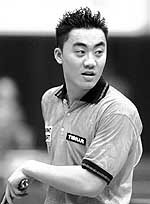 The heretofore unknown
Chinese-Dutch player Kalun Yu was a target of reporters, after his huge
upset over Liu Guoliang in the team match.
The heretofore unknown
Chinese-Dutch player Kalun Yu was a target of reporters, after his huge
upset over Liu Guoliang in the team match.
Yu is 19 years old, and 1.8 m tall. He is a left-hander with a shakehands grip. He immigrated to the Netherlands with his parents at the age of two, and has been playing table-tennis since he was eight years old. Two years ago, the Dutch national coach Yang Jianhua brought him into the national team, and he played in the last Worlds. Now he is playing in the second league in Germany.
In today's match, Yu quickly got used to Liu's serves, and limited the effectiveness of Liu's 3rd-ball attacks. He won the match 21-19 and 22-20, beating a player rated higher than him by more than 260 spots. This is a big surprise.
After the match, the youthful Yu was a little uncomfortable talking to the reporters. Through another ex-Chinese player Chen Song, we learned that Yu does not speak Mandarin, and can only understand a little Cantonese.
On the individual events, Yu said that he is ranked 270 in the world, so he will face tough competition ahead. First he has to go win the qualification round, then he can play in the main draw. But he is confident of his chances.
Chung's notes: In yesterday's report, there was a mistake where it
said Yu was born in the Netherlands. It's amazing that Yu does not have
problems with Liu's serves, since one would expect left-handers to have
more problem seeing his serves. In Manchester, Liu was also eliminated
by a relatively unknown left-hander in men's singles. There is a photo
of Yu playing against Liu at the Butterfly site, dated April 25. After
April 25, it may be on a different page, since that page gets updated.
One huge problem with the Osaka Worlds is that different tables are being
used in the same event. Liu was playing on a regular Nittaku table, and
previously the Chinese have played on the futuristic-looking San-Ei tables.
Coach Cai has complained about this problem.
 In Osaka, the ITTF executives
are discussing how to change the female players' uniforms. They want to
apply pressure to the manufacturers to come up with outfits that better
show the female figure.
In Osaka, the ITTF executives
are discussing how to change the female players' uniforms. They want to
apply pressure to the manufacturers to come up with outfits that better
show the female figure.
Even though table tennis has a lot of supporters in Asia, it is still not yet a popular sport worldwide. Compared to tennis, it receives much less attention and media coverage. To address this problem, the ITTF plans to come up with a drastic change: let the women players wear sexier uniforms.
The ITTF looked at the excitement caused by tennis players such as Kournikova with envy. Its own female players all wear basically the same outfits as the men, therefore totally hiding their feminine attractiveness.
An ITTF spokesperson said: "It is not easy to convince the clothing manufacturers to try this, but we plan to develop an attractive and marketable image of the female player."
The spokesperson for the German TTA strongly agreees. "Many people think that table-tennis is a conservative sport. It's time to change that impression. The sport needs the individual's star power."
The European women players are showing interest in this proposal. Sweden's
A. Swensson said: "The outfits are all designed for the male players. I
like to wear tighter outfits myself."
 A very photogenic
Li Ju.
A very photogenic
Li Ju.
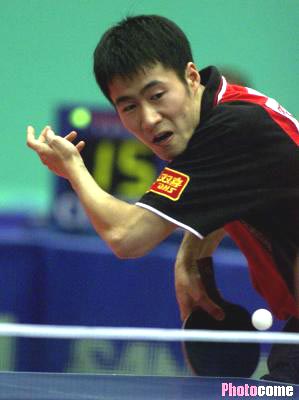 Wang Liqin
and his not-too-hidden serve.
Wang Liqin
and his not-too-hidden serve.
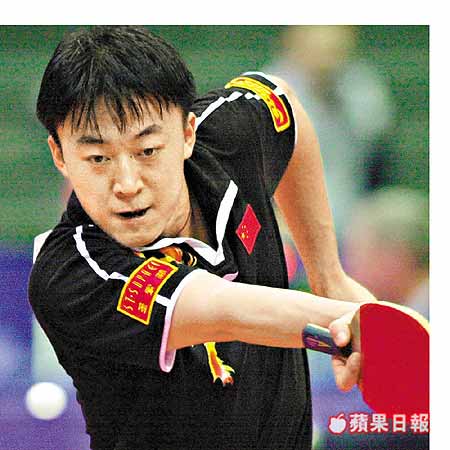 Ma Lin blocking.
Ma Lin blocking.
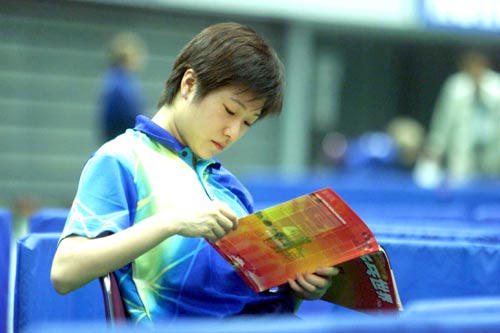 Chen Jing
reading the Table Tennis World Special Edition.
Chen Jing
reading the Table Tennis World Special Edition.
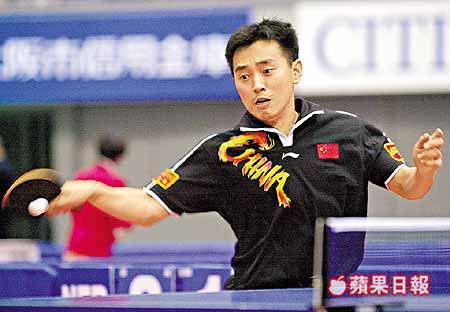 Kong loop-driving.
Kong loop-driving.
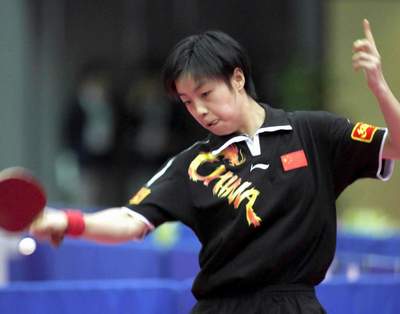 Zhang Yining
and her forehand loop. Notice the outstanding similarity between her form
and Kong's in the above picture.
Zhang Yining
and her forehand loop. Notice the outstanding similarity between her form
and Kong's in the above picture.
 Hong Kong's
Song Ah Sim serving against Taipei. Song won both matches in a surprisingly
tight contest against Chinese Taipei. She scored a come-from-behind upset
over Chen Jing.
Hong Kong's
Song Ah Sim serving against Taipei. Song won both matches in a surprisingly
tight contest against Chinese Taipei. She scored a come-from-behind upset
over Chen Jing.